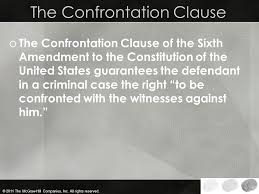Confrontation Clause: Testimony of Trained Breathalyzer Test Observer Admissible
People v Hao Lin
28 N.Y.3d 701 (2017)
New York Court of Appeals
Decided on February 16, 2017
Issue: Whether the Confrontation Clause was violated when the trial court allowed the live testimony of a police officer who did not administer the defendant’s breathalyzer test, but only observed the testing.
Holding: The Court held that there was no Confrontation Clause violation and that the observing police officer’s live testimony was admissible even though he only observed the given test and did not personally administer it. Given that the observing officer completed proper training to successfully operate the same breathalyzer machine used on the defendant and understood how to read and comprehend the printout results from the machine, the officer’s testimony was reliable and able to take the place of the officer who directly administered the test.
Facts: Defendant was arrested for driving while intoxicated and was taken to a police station where he was given a breathalyzer test. Officer Harriman administered the breathalyzer test while Officer Mercado observed. Mercado observed the performance and recorded the procedure on video. For the first two tests, the defendant did not properly blow into the machine and an error signal sounded. The third test was successful and provided a reading of a .25% blood alcohol content.
Harriman was unable to testify at trial, so Mercado testified instead and stated that the defendant was intoxicated. The defendant was convicted of two counts of DWI. The Appellate Term reversed and remitted the judgment, holding that the defendant’s confrontation rights were violated on the grounds that a vital piece of information was missing from the checklist that Mercado did not personally observe.
 Analysis: The Confrontation Clause of the Sixth Amendment provides that the testimony of a witness against a criminal defendant is inadmissible unless the witness appears at trial or, if the witness is unavailable, the defendant previously had an opportunity for cross-examination. Melendez-Diaz v Massachusetts, 557 US 305, 309 (2009); see People v Pealer, 20 NY3d 447, 453 (2013), cert denied ___ US ___, 134 S Ct 105 (2013). Here, the case concerns the admission of testimony made by individuals who were unavailable for cross-examination. As noted by the Court, several recent Court of Appeals and United States Supreme Court cases have called into question the admissibility of documents such as affidavits and forensic reports where there was no live testimony or where there was, instead, testimony of an individual who was familiar with the testing procedure?but did not hold a direct connection to the specific test administered to the defendant. See Bullcoming v New Mexico, 564 US 647 (2011); Melendez-Diaz v Massachusetts, 557 US 305 (2009); People v John, 27 NY3d 294 (2016). Although the facts of these cases are not completely parallel to the present case, the Court of Appeals found them to still be analogous and applicable.
Analysis: The Confrontation Clause of the Sixth Amendment provides that the testimony of a witness against a criminal defendant is inadmissible unless the witness appears at trial or, if the witness is unavailable, the defendant previously had an opportunity for cross-examination. Melendez-Diaz v Massachusetts, 557 US 305, 309 (2009); see People v Pealer, 20 NY3d 447, 453 (2013), cert denied ___ US ___, 134 S Ct 105 (2013). Here, the case concerns the admission of testimony made by individuals who were unavailable for cross-examination. As noted by the Court, several recent Court of Appeals and United States Supreme Court cases have called into question the admissibility of documents such as affidavits and forensic reports where there was no live testimony or where there was, instead, testimony of an individual who was familiar with the testing procedure?but did not hold a direct connection to the specific test administered to the defendant. See Bullcoming v New Mexico, 564 US 647 (2011); Melendez-Diaz v Massachusetts, 557 US 305 (2009); People v John, 27 NY3d 294 (2016). Although the facts of these cases are not completely parallel to the present case, the Court of Appeals found them to still be analogous and applicable.
First, the Court addressed Bullcoming v New Mexico, a US Supreme Court case that determined that the defendant’s Confrontation Clause rights were violated. There, the defendant’s blood test report was introduced through the testimony of an analyst who did not administer the defendant’s blood test or directly observe the testing. The Court held that the information provided by the analyst was not admissible because the live testimony of the person familiar with the particular test performed on the defendant was required. The Supreme Court held that the testimony of the analyst who was not directly involved was insufficient because it cannot convey what the testing analyst knew or observed about the particular test and testing process he or she employed (id. at 66) and cannot expose any lapses or lies by the analyst (id. at 662).
The Court of Appeals ruled similarly in People v John. There, no administrator or witness of the DNA test performed on the defendant was able to testify at trial. However, in People v Brown (13 NY3d 332 [2009]), the Court of Appeals held that there was no Confrontation Clause violation because the facts were so distinguishable from John. In Brown, the testifying witness supervised the generation of the D NA profile and examined and interpreted data. See John, 27 NY3d at 310, citing Brown, 13 NY3d at 337, 340). So, even though the testifying witness may not have personally administered the test, he still witnessed or observed the testing of the defendant, which renders his ability to cross-examine the defendant reliable.
NA profile and examined and interpreted data. See John, 27 NY3d at 310, citing Brown, 13 NY3d at 337, 340). So, even though the testifying witness may not have personally administered the test, he still witnessed or observed the testing of the defendant, which renders his ability to cross-examine the defendant reliable.
By applying those rules to the present case, the Court of Appeals concluded that there was no Confrontation Clause violation. Like the testifying analyst in Brown, Mercado was present throughout Harriman’s entire commission of the breathalyzer test and testified that he was fully trained to operate the machine to correctly recognize the accuracy and results of the test.
Further, the third test printed out a reading of the blood alcohol content results, which was equally discernable by both Harriman and Mercado regardless of who personally administered the test. The printout was automatically produced by the machine and not by Harriman, so the results were unbiased.
The Appellate Division only found that there was a confrontation violation because Mercado did not observe the simulator solution temperature displayed on the machine, which was a step included in the testing procedure. The Court of Appeals held that because no statement was made by a non-testifying witness against the defendant regarding the temperature displayed on the machine, so there was no confrontation violation. In addition, the trial record indicated that when the temperature of the solution is outside the temperature required for testing, the machine will shut itself down and fail to perform the test, which obviously did not occur here.
Given the rules and facts of the case, the Court of Appeals held that Mercado’s testimony was admissible. Mercado observed the test in its entirety and observed Harriman perform each step on the required checklist, he read the printout results from the machine, and he was a trained and informed operator of the same breathalyzer machine used by Harriman on the defendant. Accordingly, no Confrontation Clause violation was rendered.
